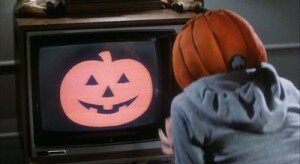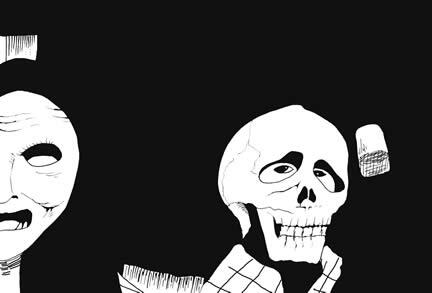The Halloween Anomaly, Season of the Witch
Some pretty great minds went into creating Halloween’s third film, Halloween Part III: Season of the Witch (1982). Tommy Lee Wallace wrote and directed the film with contributions from Debra Hill and John Carpenter himself! While this film was supposed to be the start of what they all hoped would become a Halloween anthology series (that would never be), it is most certainly a hidden gem of a horror movie altogether! The movie took a lot of risks to create a masterpiece that has developed a definite cult following some 30-some years later! And the worst part is the more time that goes by, the creepier the movie gets…almost in a predictive sort of way!
Behind the Scenes: Halloween Part III
The creators of the Season of the Witch found a hidden fear in the fabric of society. The movie successfully showcases horror by way of brainwashing and mind-control, conspiracy and full-on hopelessness. Here are some of the most interesting facts in the making of Halloween Part 3: Season of the Witch…
Cameo Pharmaceutical
In Halloween (1978), Dr Loomis suggests a drug called “Thorazine” to Nurse Chambers. Thorazine is supposed to suggested to suppress Michael Myers’ mental and psychiatric disorders. In Halloween III: Season of the Witch (1982), this same drug is prescribed by Dr Challis to Harry Grimbridge during his stint in the hospital!
Truly Hypnotizing
The creators were insistent upon the Silver Shamrock theme song and commercial playing as much as possible throughout the film. Branding the film with the Silver Shamrock Novelties company logos, stickers, and themes was imperative in creating the fear that is experienced throughout the film. Ultimately, the Silver Shamrock theme song plays a total of 14 times throughout the movie!
Where Was Halloween Season of the Witch Filmed?
The film was produced in California. The gas stations are located off the Sierra Highway, and also in Loleta (both are still there). The hospital was in Sylmar, however, no longer remains. And the Silver Shamrock commercials were filmed in Sierra Madre. The movie also uses the Rose of Shannon Motel and a manufacturing factory in Loleta. Random scenes are shot all over L.A. As well.
Voicing Cameo
Halloween’s previous films starred Jamie Lee Curtis. She is also the phone operator in the third installment, Season of the Witch. The role is uncredited, but she sounds absolutely convincing! She is also the voice reciting the curfew.
Coining Witchcraft in the Computer Age

Several people, including the film’s director (Tommy Lee Wallace), credit Debra hill with the concept of introducing witchcraft to the computer age. Witchcraft had not previously been used to fuse with or take over technology in the way it is used throughout the Silver Shamrock story.
The Masks Were Real
The three Silver Shamrock masks present throughout the film were mass produced as a part of a merchandising campaign. Don Post was selected for the job, as he had previously done similar merchandising for E.T. (1982), Star Wars (1977), and Planet of the Apes (1968). The producers felt that if the masks were released early enough, fans would purchase them prior to the film’s release and wear them to the actual movie theater.
A Masked Plot
Tommy Lee Wallace, writer and director of Season of the Witch, explained that he had an intricate plan for the three masked sold by the Silver Shamrock Novelties company. Each mask was going to represent another film in the series…thus connecting Season of the Witch (loosely) with the other movies in the franchise. Unfortunately, after this third movie in the franchise totally bombed at the box office, Halloween would have to return to their cash cow, famed slasher Michael Myers, instead of merely leaving behind his mask.
Mostly Acting Newbies
Almost all of the cast of the third Halloween film were total newbies…only having previous credits as extras or cameo types of appearances. There were a couple bigger names, but ultimately the film relied upon newer, green talent. Amazingly, the acting itself is pretty alright and the movie maintains a fairly strong level of suspense.
Halloween Cameo Appearance
Halloween (1978) itself receives a cameo appearance roughly 1:17 to 1:19 minutes into the movie. The movie can be seen played on a small TV as a Silver Shamrock victim sits strapped to a chair and locked in a room with a mask over his head.
The Silver Shamrock Theme Song
The Silver Shamrock theme song is based on the popular “London Bridge” song. London Bridge was in the public domain, so it became a clear choice as a catchy, modifiable tune that people would recognize, remember, and be able to follow along with.
Robot Guts
Robot guts was seemingly new territory as the staff ended up using orange juice. The high-in-vitamin-c citrus drink can be seen pouring from the robots’ mouths throughout the films.
Got Milk?

Although the crew used orange juice for robot blood, the Silver Shamrock factory was actually producing something much different before being cast in Season of the Witch. A milk factory was used as the Silver Shamrock headquarters due to its availability, location ambiance and size.
Inspirations for Making the Film
There are obvious tips of the hat to both Don Siegel (Invasion of the Body Snatchers general concept) and George A Romero (Season of the Witch film title). Halloween itself (the holiday, not the movie franchise), deserves an applause, for without Halloween, none of Season of the Witch would be possible! The movie focuses on the sale of Halloween masks to would-be trick-or-treaters, days before…you guessed it! Halloween!
An Under appreciated 80s Horror Movie
Season of the Witch is one of the most original horror movies to come out of the 80s, despite drawing a lot of inspiration from even very popular pieces such as Invasion of the Body Snatchers (1956) and Season of the Witch (1972). The acting is pretty decent, believable. The characters are drawn perfectly. The film style and natural fear is excellent, in traditional Carpenter-Hill fashion. And Tommy Lee Wallace totally knocks the ball out of the park when it comes to directing the movie. Regardless of its amazing feats, the brilliant attempt at reinventing the Halloween franchise came a little too early; Thus, Season of the Witch joins the ranks of underappreciated 80s horror movies.
And if it were still possible to actually buy Silver Shamrock masks, every fan absolutely would!

Tritone’s love of horror and mystery began at a young age. Growing up in the 80’s he got to see some of the greatest horror movies play out in the best of venues, the drive-in theater. That’s when his obsession with the genre really began—but it wasn’t just the movies, it was the games, the books, the comics, and the lore behind it all that really ignited his obsession. Tritone is a published author and continues to write and write about horror whenever possible.
